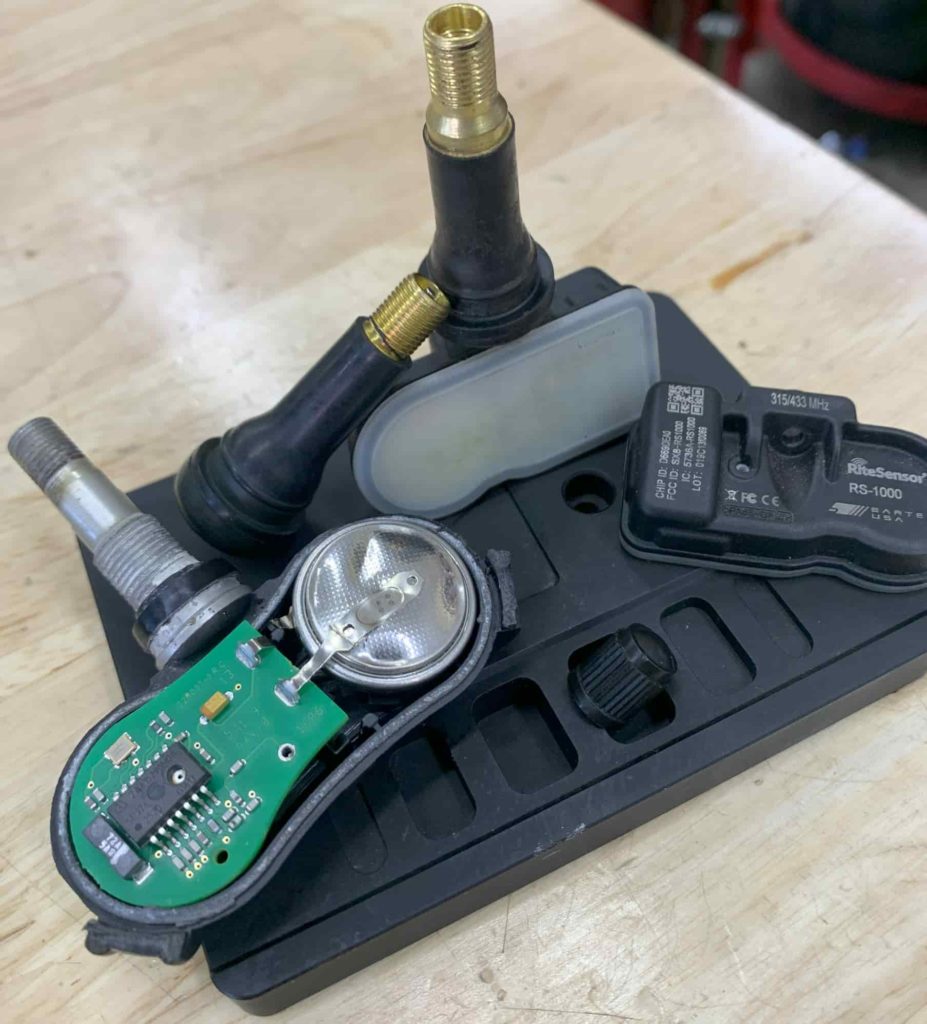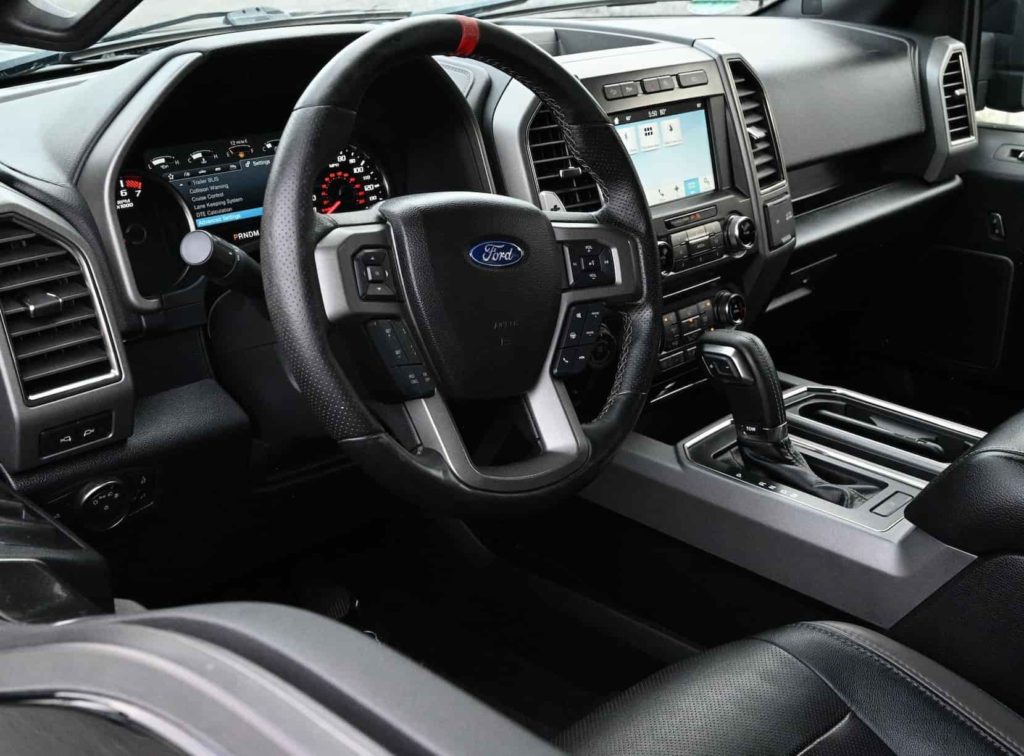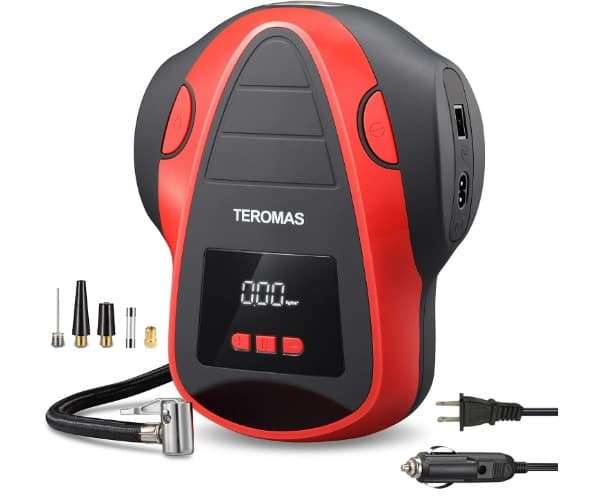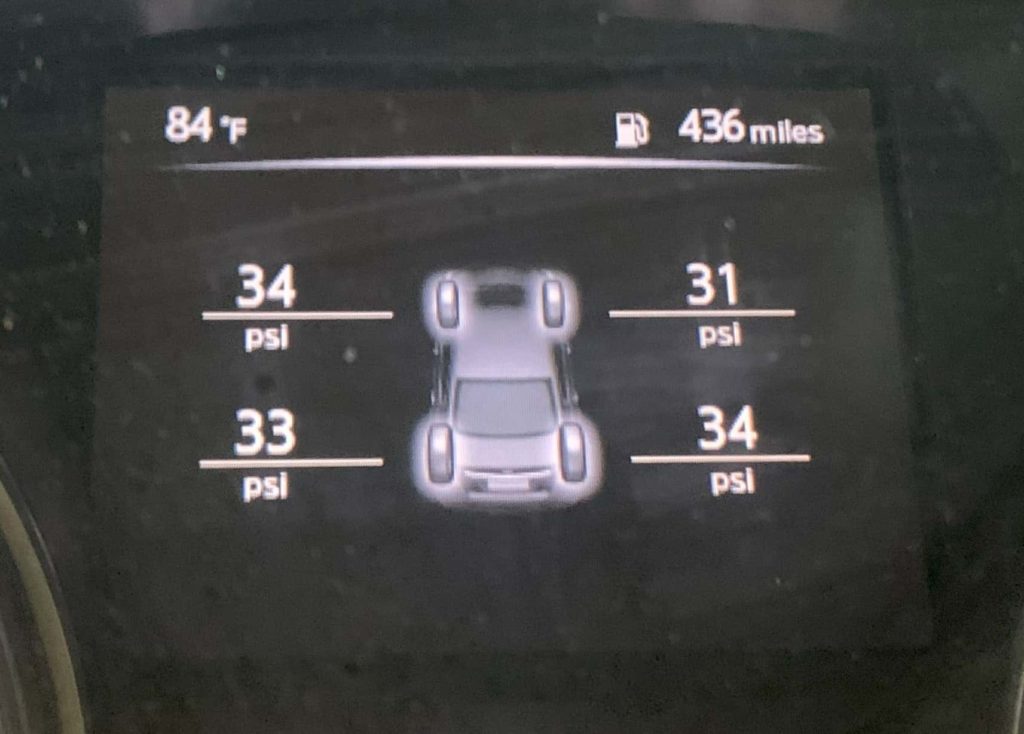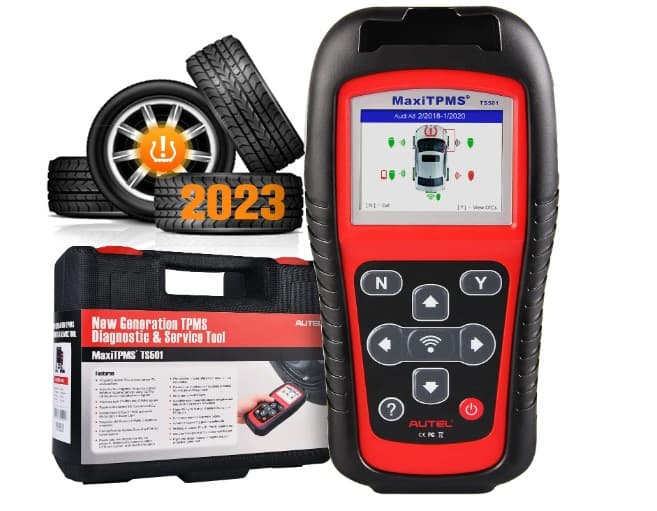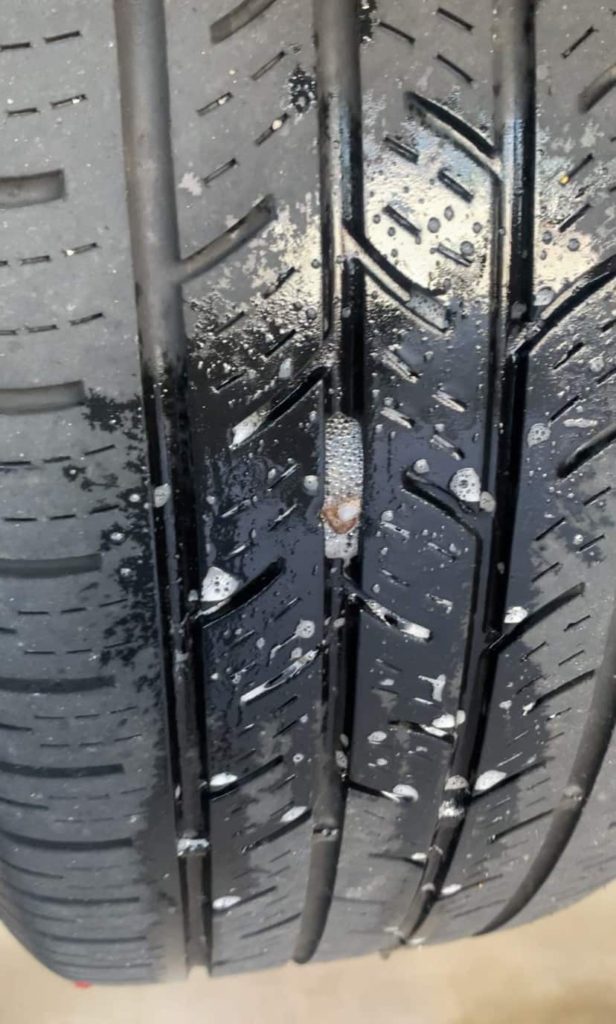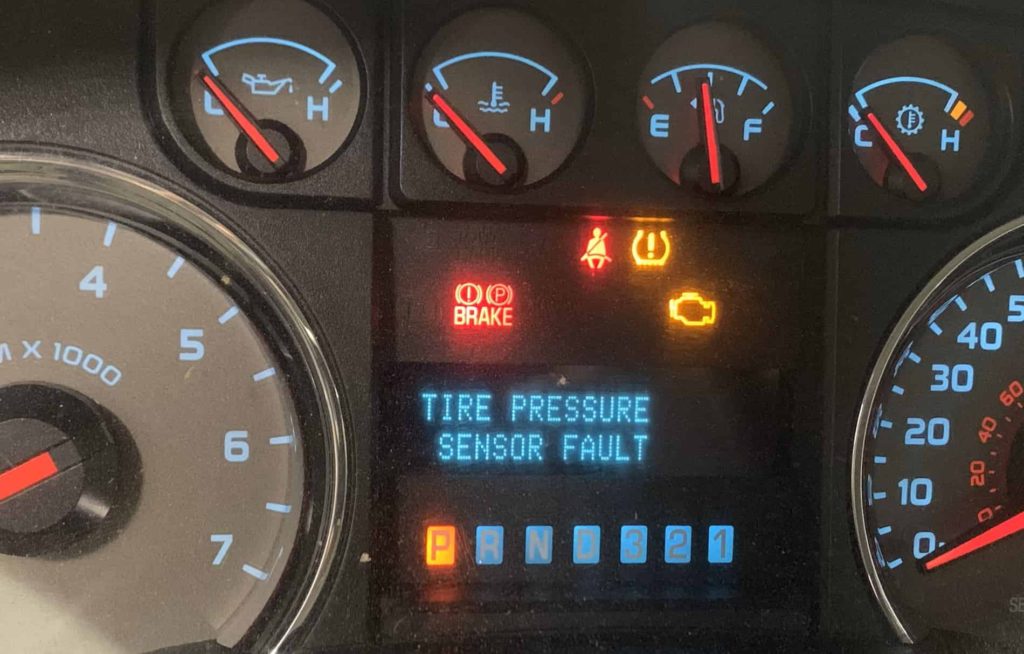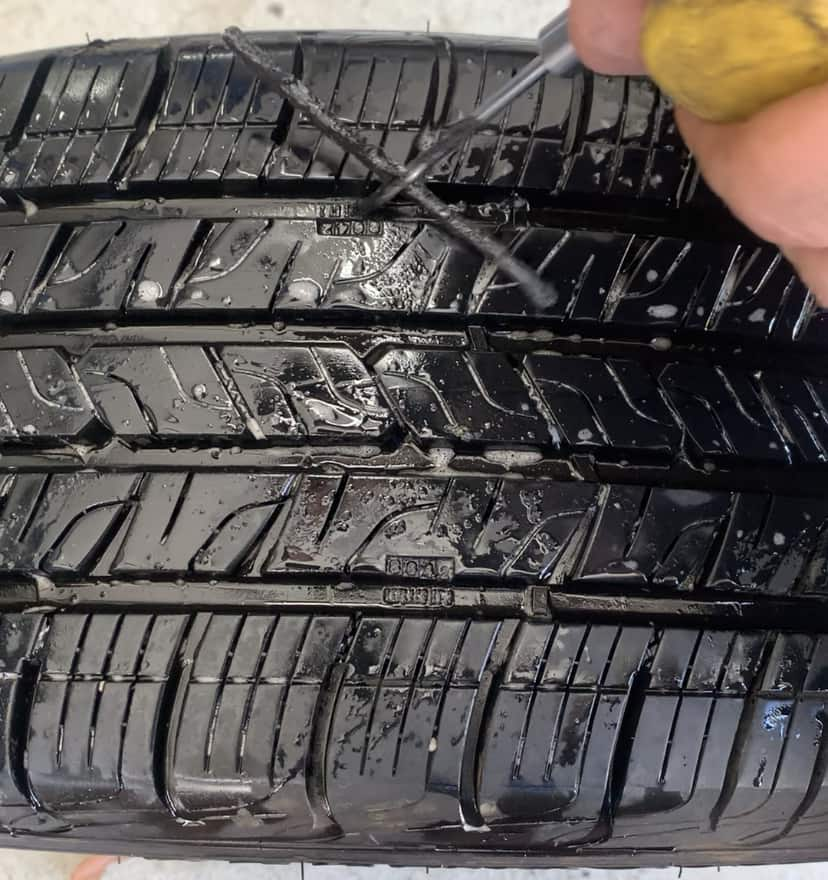What is the Ford Maverick Tire Pressure Monitoring System?
The Ford Maverick’s tire pressure monitoring system is a warning system that notifies the driver when the tire pressure in one or more tires has dropped below a certain threshold. Typically 15-20% below the recommended 35 Psi will trigger the low tire pressure light. It combines cutting-edge sensors, advanced data transmission technologies, and smart analytics all wrapped into one system; TPMS.
How Does the Ford TPMs Work?
Tire Pressure Sensors
At the heart of the Ford Maverick TPMS are tire pressure sensors, which are small battery powered electronic devices mounted inside each tire. Each sensor is either part of the valve stem (mounted on the base of the valve) or strapped to the inside of the wheel using a metal band. These sensors constantly monitor and measure the air pressure and temperature within the tire and use the piezoelectric effect to convert the tire pressure into an electrical signal.
Data Transmission
The sensors aren’t just passive collectors of data; they are also equipped with a small transmitter to send and receive information. When the truck is moving or when requested by the TPMS receiver module, the transmitters send radio frequency (RF) signals to relay the current tire pressure information. The Ford Maverick sensors use either 315 Mhz or 433 Mhz radio signals. The transmitters are built to be low-energy consuming to maximize each sensor’s battery life.
TPMS Receiver Module
The TPMS Receiver Module is the “brain” of the whole operation. It is powered by the truck’s main 12 volts battery supply. The module is connected to the Ford Mavericks main onboard computer (ECU) and is responsible for interpreting the signals received from each tire’s pressure sensor. It not only monitors the real-time pressure but also considers other variables like tire temperature and vehicle speed to make the readings as accurate as possible. The receiver module also compares the current tire pressure to the recommended pressure set by Ford.
Low Tire Pressure Alerts
Once the TPMS Receiver Module interprets the data and determines that the tire pressure is out of the designated safe range, it sends an alert to the driver through the vehicle’s dashboard. The Ford Maverick low tire pressure alert is a yellow exclamation point as well as a “Low Tire Pressure” warning message. The display will also highlight which tire is low on air.
How to Reset Ford Maverick Tire Pressure Light (2022-2024)
Check and adjust the tire pressure to the recommended pressure when the tires are cold.
Drive the Ford Maverick for a few miles over 20 Mph (32km/h)
The low tire pressure light will turn off after a few minutes of driving.
How to Train the Ford Maverick Tire Pressure Sensors
Follow this procedure after rotating tires or if your tires are replaced and the wheels/tire pressure sensors are not put back in the same positions they were in.
After the wheels have been put back on the Ford Maverick, drive above 20 Mph for a few minutes. (At least 2 minutes of driving)
Turn the key to the ON position. Engine off.
Press the hazard lights button on and off 3 times within 10 seconds.
You will hear the horn beep one time if the Ford Maverick is in “Reset Mode”
The tire pressure light will begin flashing and a warning will pop up explaining which tire needs training.
If you do not hear the beep, start over.
Hop out of the truck and starting with the left front tire, (going clockwise) take the valve stem cap off and push the valve stem core in and start releasing air from the tire.
When you hear the horn beep, stop.
Move onto the front right tire (passenger side). Release air until the horn beeps.
Move onto the rear right tire. Release air until the horn beeps.
Move onto the rear left tire. Release air until the horn beeps.
After the 4 tire beeps, check and inflate all 4 tires’ pressure back to the recommended cold pressure values.
The display inside the truck will now say “training complete”
Select OK
Sensor Training Tips:
Perform this procedure at least 3 feet away from other vehicles
Always perform this procedure in the order explained above.
Do not wait more than 2 minutes between each tire sensor reset
If you hear a double horn beep you need to repeat the procedure.
How to Change Ford Maverick Tire Pressure Unit - 4.2 Inch Display Screen
Select settings and press the menu button
Select Display
Select Tire Pressure
Select one of the Tire Pressure Units
How to Change Ford Maverick Tire Pressure Unit - 6.5 Inch Display Screen
Select Display Setup
Select Tire Pressure
Select one of the Tire Pressure Units
What Can Cause a Ford Maverick Low Tire Pressure Alert?
TPMS Sensor Issues: Malfunctions in the TPMS or incorrect pressure readings on the Ford Maverick information display can arise from faulty sensors or depleted sensor batteries.
Causes for Reduced Tire Pressure: Factors such as temperature fluctuations, leaking valve stems, seal leaks around the tire bead, punctures, cracked rims, changes in altitude, natural air loss, and aging tires can all contribute to lower tire pressure.
Risks in TPMS Sensor During Tire Installation: Carelessness while mounting new tires onto wheels may result in damaging the TPMS sensor.
Incorrect Tire Inflation Levels: Both over-inflating and under-inflating tires will activate the tire pressure warning light.
Radio Frequency Interference: Nearby electronic devices operating on radio frequencies similar to those used by TPMS sensors (433 Mhz or 315 Mhz) can disrupt pressure readings and cause system malfunctions. (Although this is very rare, you can manually check the tire pressures if you think something is off with the TPMS.)
TPMS Receiver Wiring Issues: Compromised wiring or connectors linked to the TPMS receiver module will cause a tire pressure system malfunction. (flashing tire light)
Absence of Sensors in Alternate Wheels: Utilizing wheels that lack tire pressure sensors such as the spare tire or a different set for winter or summer, will result in a flashing tire light (TPMS malfunction). If using a second set of wheels, swap the sensors over or get a second set of sensors.
Understanding Tires
How Does Weather Affect Tire Pressure?
Weather conditions can significantly influence tire pressure. Cold temperatures often lead to a reduction in tire pressure as the air inside the tires contracts and commonly triggers the low-pressure warning light. Conversely, hot or warm weather causes the tires to increase in pressure. For every 10-12 degree change in temperature, the tires in your Ford Maverick will change by about 1-2 Psi.
How to Check Tire Pressure Using Ford Maverick Information Display
Use the UP and DOWN arrows on the steering wheel and scroll through until you reach the tire pressure display on the screen.
How to Manually Check Tire Pressure
Tire Pressure Gauge: Use a digital tire pressure gauge.
Cold Tires are Best: For accurate pressure readings, check the tire pressure when the tires are cold which means the vehicle has been stationary for at least three hours.
Locate the Valve Cap: Unscrew the valve cap and put it somewhere safe so it doesn’t get lost.
Insert Gauge: Firmly press the tire pressure gauge onto the valve stem. Ensure a good seal to avoid air leakage.
Read the Gauge: Quickly read the pressure gauge and pull the gauge off the valve stem.
Compare with Door Jamb: Check the reading against the recommended tire pressure of your Ford Maverick on the door jamb sticker. The sticker is yellow and white and has a “front” and “rear” pressure table. It is 35 Psi in front and rear tires.
Adjust Pressure: If needed, inflate the tire until it reaches the recommended 35 Psi. Alternatively, if the tire is overinflated, release some air by gently pressing in the valve stem core.
Replace Valve Cap: After adjusting, screw the valve cap back on.
Repeat: Follow steps 3-9 for the other 3 tires.
2023 Ford Maverick Wheel Size & Tire Pressures
TIRE SIZE | FRONT PSI | REAR PSI |
225/65R17 | 35 | 35 |
235/65R17 | 35 | 35 |
225/60R18 | 35 | 35 |
SPARE | 60 | 60 |
What's the Impact of Driving the Ford Maverick with Low Tire Pressure?
Reduced Fuel Efficiency & Engine Performance: Low tire pressure increases rolling resistance and tire friction, making the engine work harder to move the truck, thereby impacting its overall performance and reducing the truck’s miles per gallon.
Decreased Handling Stability: Low tire pressure can make the Ford Maverick harder to control and steer, particularly during turns or when road conditions are poor.
Increased Tire Wear: Tires with insufficient pressure wear out unevenly and more rapidly, necessitating earlier replacement.
Heightened Risk of Blowouts: Under-inflated tires are more susceptible to overheating which can eventually result in a tire blowout.
Compromised Off-Roading Capabilities: The Ford Maverick’s off-road performance can be significantly impaired due to underinflated tires, affecting traction and control on uneven terrains.
Poor Braking Performance: The truck’s braking system can be inefficient and take longer distances to stop.
Reduced Load Carrying Capacity: The truck’s ability to carry heavy loads safely is compromised, posing risks when hauling or towing.
If all of the truck’s tires are intentionally lowered for off road driving or carrying heavy loads, this is different from having one or more tires with low tire pressure.
Diagnosing the Ford Maverick TPMS
When the Ford Maverick tire pressure warning light turns on, there is always a cause. If your confident that all the tires are at the correct pressures, the tire light is typically on for one a few reasons:
One or more tires is leaking air.
One or more tire pressure sensors is low on or has a dead battery.
The tire pressure sensors are no longer communicating with the TPMS receiver module or ECU.
Here is a list of potential causes and solutions to turning off the Ford Maverick low tire pressure light:
Solution 1: Is a Tire Losing Air?
The most common reason the low tire pressure light is on is due to a leak of some kind. If you inflate a tire low on air and find that the warning light deactivates or resets after driving the truck only to light up again—be it in a matter of minutes, hours, or days—this is a strong indicator of a leak in that particular tire or wheel. It’s time to pinpoint the source of the leak! If a tire is losing air, it is leaking air.
Solution 2: Manually Force a TPMS Reset
To manually reset the low tire pressure alert on the Ford Maverick you can erase the diagnostic trouble code from the truck’s computer. This involves disconnecting the main 12-volt battery which in turn interrupts power to the Engine Control Unit (ECU). Before proceeding ensure the ignition is switched off and always start by disconnecting the negative battery terminal first. Make sure all electrical equipment such as the lights and radio are shut off. Disconnecting the battery will clear all temporary Diagnostic Trouble Codes (DTCs) from the ECU including the ones triggering the tire pressure warning. Once you reconnect the negative terminal the vehicle initiates its “relearning” phase. To assist this process drive at a consistent speed of 50 mph for a minimum of 30 minutes. If the low tire pressure warning reactivates either during or after this drive, it likely suggests a malfunctioning sensor that needs replacement or a tire leaking air.
Solution 3: Find the TPMS Sensor Causing the Tire Light to Turn On
If you’re confident that your tires are not leaking and you want to identify the sensor responsible for activating the tire pressure warning light, you can evaluate each sensor using a TPMS diagnostic tool. The procedure for doing so is generally the same regardless of the brand or model of the diagnostic device you’re using. Follow the tools instructions to sync the tool to the Ford Maverick. To check each sensor, place the diagnostic tool near the tire’s valve stem and select the “test” or “trigger” option. After all the sensors have been examined, the tool will generate a battery health report for each one. If any sensor shows a “low” battery status, fails to update, or cannot be registered or tested, it’s a sign that the specific TPMS sensor needs to be replaced.
Solution 4: Why Does the Tire Light Turn On and Off By Itself?
If you start your Ford Maverick and notice the tire pressure light comes on but then switches off as you continue driving, this often suggests that the tire pressure is slightly below the recommended cold inflation level. This situation is commonly observed with cold tires or ones that haven’t been driven recently; as they heat up, the pressure increases and causes the warning light to go off on its own. To resolve this, ensure that the front and rear tires are both set to 35 Psi when they are cold.
Solution 5: Release Air then Over Inflate the Tire
If you’re sure the tires are not leaking air, you can attempt to wake or reestablish communication between the tire pressure sensor and the Ford Mavericks TPMS receiver module/ECU. First release about 10-15 Psi from the tire by pressing the valve stem core in. Wait a few moments and then start inflating the tire. Instead of inflating the tire to 35 Psi, inflate it to 40 Psi. With the tire or tires overinflated, drive the truck for at least a few minutes at speeds over 20 Mph. Afterward, readjust the tire pressures back to the recommended 35 Psi and then drive the truck again for a few minutes over 20 Mph.
Solution 6: Find the Tire Leak
To locate a tire leak, you’ll need a few basic supplies: a spray bottle, soap, water, and a tire inflator. Start by identifying which tire is losing air and inflate it to 35 Psi. Then, prepare a soapy solution in a spray bottle by mixing water and soap (alternatively, you can use a pre-made solution like Windex). Liberally apply this soapy mixture all over the tire and make sure to cover the wheel’s bead seal and the valve stem. Allow the solution to sit for a short while before carefully inspecting the tire for tiny bubbles. Any air escaping due to a puncture or any other form of leakage will cause small bubbles to appear at the source of the leak. Once you spot these bubbles you’ve successfully identified the leak’s location!
Tire Pressure Sensor Batteries
Every wheel on the Ford Maverick is equipped with its own TPMS sensor, each of which is energized by its own separate battery. These batteries are silver-oxide and are similar looking to those found in wristwatches. Housed in a plastic shell, they are directly soldered to the sensor’s microcontroller unit. These batteries usually last between 5 to 10 years or 100,000 miles. When the battery in a sensor depletes, the whole sensor must be replaced. Various external factors can affect the battery’s lifespan. It’s worth noting that replacing one sensor doesn’t automatically imply that all the others need to be replaced as well.
Common Questions About the Ford Maverick TPMS
Is it Safe to Drive with the TPMS Light On?
When the low tire pressure warning light activates in your Ford Maverick it’s important to stop driving and check your tire pressures. Understanding the cause of why the tire light is on is vital for assessing whether it’s safe to drive or not. Driving with the tire light on and not knowing why it is on is not recommended.
Why is the Ford Maverick TPMS Light Flashing?
A TPMS malfunction occurs when one or more tire pressure sensors lose their ability to communicate with the Ford TPMS receiver module or the ECU. In such cases, the tire pressure warning light will blink for about a minute and then remain on each time you start the Ford truck. This generally indicates that a tire pressure sensor likely needs replacement. This is why when you are driving with the spare tire on, the tire light malfunctions. It’s because the TPMS receiver module knows that a wheel on the truck does not currently have a pressure sensor in it. It’s important to note that a TPMS malfunction is not related to low tire pressure; rather it’s an issue with the tire pressure monitoring system itself.
Are Tire Plugs Safe to Use?
Tire plugs offer a reliable method for repairing a punctured tire. When applied properly, they can seal the hole in the tire and last for the duration of the tire’s life. However, we strongly suggest never using them in the sidewall of a tire.
Are Tire Sealants Safe to Use?
We recommend only using tire sealants in urgent situations and as a temporary solution. These sealants can harm the internal circuitry of the tire pressure sensors and also affect tire balance. After using a sealant it’s important to take your Ford Maverick to a tire shop to clean the tire and evaluate the condition of the tire pressure sensor.
Everything in this article is applicable to all Ford Maverick models and versions including the Ford Maverick XL, XLT, and Lariat
Here is a link to the Ford Maverick manual : https://www.fordservicecontent.com/Ford_Content/vdirsnet/OwnerManual/SearchResults?div=f&skip-pts-cache=f9321630-ebdc-49af-9eba-e8a1535ed4d4
Please note that this blog post contains Amazon affiliate links. This means that if you make a purchase through one of these links, we at TPMSRESET.COM may earn a small commission at no extra cost to you. We only recommend products that we personally use and believe in. Thank you for supporting us.

